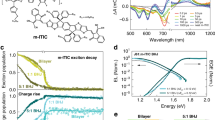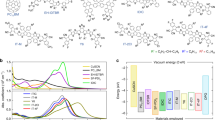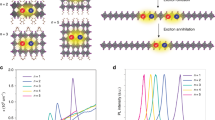Abstract
The unique properties of organic semiconductors, such as flexibility and lightness, are increasingly important for information displays, lighting and energy generation. But organics suffer from both static and dynamic disorder, and this can lead to variable-range carrier hopping1,2, which results in notoriously poor electrical properties, with low electron and hole mobilities and correspondingly short charge-diffusion lengths of less than a micrometre3,4. Here we demonstrate a photoactive (light-responsive) organic heterostructure comprising a thin fullerene channel sandwiched between an electron-blocking layer and a blended donor:C70 fullerene heterojunction that generates charges by dissociating excitons. Centimetre-scale diffusion of electrons is observed in the fullerene channel, and this can be fitted with a simple electron diffusion model. Our experiments enable the direct measurement of charge diffusivity in organic semiconductors, which is as high as 0.83 ± 0.07 square centimetres per second in a C60 channel at room temperature. The high diffusivity of the fullerene combined with the extraordinarily long charge-recombination time yields diffusion lengths of more than 3.5 centimetres, orders of magnitude larger than expected for an organic system.
This is a preview of subscription content, access via your institution
Access options
Access Nature and 54 other Nature Portfolio journals
Get Nature+, our best-value online-access subscription
$29.99 / 30 days
cancel any time
Subscribe to this journal
Receive 51 print issues and online access
$199.00 per year
only $3.90 per issue
Buy this article
- Purchase on Springer Link
- Instant access to full article PDF
Prices may be subject to local taxes which are calculated during checkout



Similar content being viewed by others
References
Coropceanu, V. et al. Charge transport in organic semiconductors. Chem. Rev. 107, 926–952 (2007)
Bässler, H. Charge transport in disordered organic photoconductors. Phys. Status Solidi B 175, 15–56 (1993)
Sarkar, D. & Halas, N. J. Dember effect in C60 thin films. Solid State Commun. 90, 261–265 (1994)
Tripathi, A. K., Tripathi, D. C. & Mohapatra, Y. N. Simultaneous and direct measurement of carrier diffusion constant and mobility in organic semiconductors and deviation from standard Einstein relation. Phys. Rev. B 84, 041201 (2011)
Xue, J., Rand, B. P., Uchida, S. & Forrest, S. R. A hybrid planar-mixed molecular heterojunction photovoltaic cell. Adv. Mater. 17, 66–71 (2005)
Xiao, X., Bergemann, K. J., Zimmerman, J. D., Lee, K. & Forrest, S. R. Small-molecule planar-mixed heterojunction photovoltaic cells with fullerene-based electron filtering buffers. Adv. Energy Mater. 4, 1301557 (2014)
Griffith, O. L. et al. Charge transport and exciton dissociation in organic solar cells consisting of dipolar donors mixed with C70 . Phys. Rev. B 92, 085404 (2015)
Ting, H. C. et al. Benzochalcogenodiazole-based donor–acceptor–acceptor molecular donors for organic solar cells. ChemSusChem 7, 457–465 (2014)
Cheyns, D., Kim, M., Verreet, B. & Rand, B. P. Accurate spectral response measurements of a complementary absorbing organic tandem cell with fill factor exceeding the subcells. Appl. Phys. Lett. 104, 093302 (2014)
Nunomura, S., Che, X. & Forrest, S. R. Charge trapping in mixed organic donor–acceptor semiconductor thin films. Adv. Mater. 26, 7555–7560 (2014)
Itaka, K. et al. High-mobility C60 field-effect transistors fabricated on molecular-wetting controlled substrates. Adv. Mater. 18, 1713–1716 (2006)
Anthopoulos, T. D. et al. High performance n-channel organic field-effect transistors and ring oscillators based on C60 fullerene films. Appl. Phys. Lett. 89, 213504 (2006)
Kwiatkowski, J. J., Frost, J. M. & Nelson, J. The effect of morphology on electron field-effect mobility in disordered C60 thin films. Nano Lett. 9, 1085–1090 (2009)
Liu, X., Ding, K., Panda, A. & Forrest, S. R. Charge transfer states in dilute donor–acceptor blend organic heterojunctions. ACS Nano 10, 7619–7626 (2016)
Bürgi, L., Friend, R. H. & Sirringhaus, H. Formation of the accumulation layer in polymer field-effect transistors. Appl. Phys. Lett. 82, 1482–1484 (2003)
Jarrett, C. P., Pichler, K., Newbould, R. & Friend, R. H. Transport studies in C60 and C60/C70 thin films using metal–insulator–semiconductor field-effect transistors. Synth. Met. 77, 35–38 (1996)
Haddon, R. C. C70 thin film transistors. J. Am. Ceram. Soc. 118, 3041–3042 (1996)
Roichman, Y. & Tessler, N. Generalized Einstein relation for disordered semiconductors—implications for device performance. Appl. Phys. Lett. 80, 1948–1950 (2002)
Sakanoue, T. & Sirringhaus, H. Band-like temperature dependence of mobility in a solution-processed organic semiconductor. Nat. Mater. 9, 736–740 (2010)
Jurchescu, O. D., Popinciuc, M., Van Wees, B. J. & Palstra, T. T. M. Interface-controlled, high-mobility organic transistors. Adv. Mater. 19, 688–692 (2007)
Leijtens, T., Lim, J., Teuscher, J., Park, T. & Snaith, H. J. Charge density dependent mobility of organic hole-transporters and mesoporous TiO2 determined by transient mobility spectroscopy: implications to dye-sensitized and organic solar cells. Adv. Mater. 25, 3227–3233 (2013)
Tummala, N. R., Zheng, Z., Aziz, S. G., Coropceanu, V. & Brédas, J.-L. Static and dynamic energetic disorders in the C60, PC61BM, C70, and PC71BM fullerenes. J. Phys. Chem. Lett. 6, 3657–3662 (2015)
Torricelli, F., Colalongo, L., Raiteri, D., Kovács-Vajna, Z. M. & Cantatore, E. Ultra-high gain diffusion-driven organic transistor. Nat. Commun. 7, 10550 (2016)
Kim, M. et al. Lateral organic solar cells with self-assembled semiconductor nanowires. Adv. Energy Mater. 5, 1401317 (2015)
Wang, N. et al. Snow cleaning of substrates increases yield of large-area organic photovoltaics. Appl. Phys. Lett. 101, 133901 (2012)
Burlingame, Q. et al. Reliability of small molecule organic photovoltaics with electron-filtering compound buffer layers. Adv. Energy Mater. 6, 1601094 (2016)
Olthof, S. et al. Ultralow doping in organic semiconductors: evidence of trap filling. Phys. Rev. Lett. 109, 176601 (2012)
Acknowledgements
This work was supported by the United States Department of Energy SunShot Program under awards DE-EE0006708 and DE-EE0005310, and the Air Force Office of Scientific Research under award FA9550-14-1-0245. We thank M. Ware for discussions regarding numerical simulations.
Author information
Authors and Affiliations
Contributions
Q.B. fabricated all samples, performed all measurements, and assisted with data fitting and analysis. C.C. assisted with current measurements, formulated theory, and performed simulations and data analysis. X.C. analysed mismatch in organic photovoltaic devices between over- and under-filled device illumination measurements. A.P. assisted with ultraviolet photoelectron spectral measurement of film energy levels. Y.Q. calculated lateral electric field strength in the channel. S.R.F. supervised the project and analysed data. Q.B., C.C. and S.R.F. wrote the manuscript together.
Corresponding author
Ethics declarations
Competing interests
The authors declare no competing financial interests.
Additional information
Reviewer Information Nature thanks N. Banerji and the other anonymous reviewer(s) for their contribution to the peer review of this work.
Publisher's note: Springer Nature remains neutral with regard to jurisdictional claims in published maps and institutional affiliations.
Extended data figures and tables
Extended Data Figure 1 Impact of channel disruption on channel currents.
Room-temperature transient currents were measured on a DTDCTB-(10 nm C60)-mixed device at L = 3 mm before and after a series of razor blade cuts was made to the organic layers, as shown in the inset. The peak height of the current pulse was greatly reduced and the peak arrival time was delayed for devices with a ‘partial cut’ that was transverse to, and spanned the width of, the ITO anode between the illumination position and the silver cathode, compared with the pristine, uncut device. Charge-diffusion simulations were performed for both geometries, where the only difference was a blocking boundary condition at the position of the partial cut. We find that charge diffusion around the cut accounts for the differences between the cut and uncut device transients, as demonstrated by the agreement between fits (lines) and the data. The partial cut was also extended such that there was no continuous organic path between the illumination position and the cathode (a ‘full cut’ device). This eliminated the response except for a residual current at time t < 200 ms arising from scattered light absorbed in the organic layers between the cathode and cut. This effect was observed in all devices exhibiting channel currents.
Extended Data Figure 2 Electron diffusion in an electrical injection device.
a, A device was fabricated to characterize charge diffusion in an electron-only electrically injected channel, with the structure shown here. Charges were injected into the C60 channel by applying a 50 V pulse between the injecting contact and the silicon substrate for 5 s. b, The transient current collected at the buried contact. A steady-state current of 0.56 μA is observed approximately 3 s after the start of the pulse, with an exponential decay time of about 400 ms. A simulation of the turn-off transient using the same optically measured parameters for D and k in Table 1 for the DTDCPB-(10 nm C60)-neat device is also shown in b (solid line). The small deviations of the fits to the electrical data are probably due to slow de-trapping of charges in the BPhen and SiO2 that are injected during the 50 V pulse. Inset, photograph of the device with 1 cm scale bar.
Rights and permissions
About this article
Cite this article
Burlingame, Q., Coburn, C., Che, X. et al. Centimetre-scale electron diffusion in photoactive organic heterostructures. Nature 554, 77–80 (2018). https://doi.org/10.1038/nature25148
Received:
Accepted:
Published:
Issue Date:
DOI: https://doi.org/10.1038/nature25148
This article is cited by
-
Organic bipolar transistors
Nature (2022)
-
π-Stacked host materials based on spirofluorene scaffolds for warm white OLEDs achieving 94.7 lm W−1 at 1,000 cd m−2
Science China Chemistry (2022)
-
Spray-coated high-efficiency small molecule solar cell based on DTS[PTTH2]2: PC71BM configurations through integrated molecular and solvent engineering
Journal of Materials Science: Materials in Electronics (2021)
-
Electronic and optical properties of gold-doped endohedral fullerenes
Journal of Materials Science (2020)
-
Development of polymeric active layer for RGB light-emitting devices: a review
Journal of Materials Science: Materials in Electronics (2020)
Comments
By submitting a comment you agree to abide by our Terms and Community Guidelines. If you find something abusive or that does not comply with our terms or guidelines please flag it as inappropriate.



